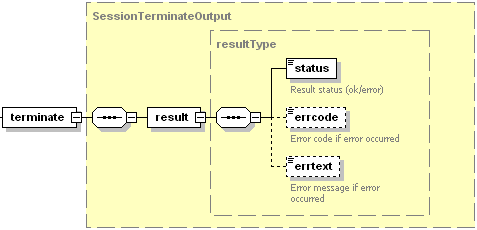Terminating Session
Use the terminate operation to close a specified session.
Request Packet Structure
A request XML packet terminating a specified session includes the terminate operation node:
<packet>
<session>
<termination>
...
</termination>
</session>
</packet>
The terminate node is presented by type SessionTerminateInput
(session.xsd) and has the following graphical representation:

Note: The interactive schema navigator for all request packets is available here: http://plesk.github.io/api-schemas/1.6.9.1/agent_input.svg.
- The session-id node is required. It specifies the session ID. For info on how to retrieve the session ID, refer to the Retrieving Sessions List section. Data type: string.
Response Packet Structure
The terminate node of the output XML packet is presented by type
SessionTerminateOutput (session.xsd) and structured as follows:

Note: The interactive schema navigator for all response packets is available here: http://plesk.github.io/api-schemas/1.6.9.1/agent_output.svg.
- The result node is required. It wraps the response retrieved
from the server. Data type: resultType (
common.xsd). - The status node is required. It specifies the execution status of the operation. Data type: string. Allowed values: ok | error.
- The errcode node is optional. Is returns the error code if the terminate operation fails. Data type: integer.
- The errtext node is optional. It returns the error message if the terminate operation fails. Data type: string.
Samples
The request packet terminating the session win ID a66734b looks as follows:
<packet>
<session>
<terminate>
<session-id>a66734b</session-id>
</terminate>
</session>
</packet>
Response:
<packet>
<session>
<terminate>
<result>
<status>ok</status>
</result>
</terminate>
</session>
</packet>
If the session was not found on the server, the response looks as follows:
<packet>
<session>
<terminate>
<result>
<status>error</status>
<errcode>1013</errcode>
<errtext>Session does not exist</errtext>
</result>
</terminate>
</session>
</packet>